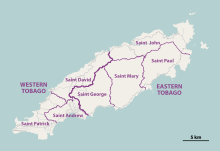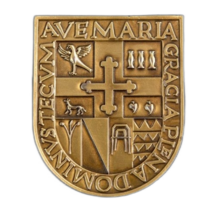|
Antonio Vélaz de Medrano, I Marquess of Tabuérniga
Antonio Vélaz de Medrano y Altamirano, I Marquess of Tabuérniga[1] (1637 in Labastida – 3 August 1683 in Spa, Belgium)[2] was a distinguished Basque-Spanish noble, Knight of the Order of Santiago and military figure during the reign of Philip IV and Charles II of Spain. The Marquess of Tabuérniga served as governor of the strategic city of Nieuwpoort in Flanders and Sergeant General of Battle. By Royal Decree, the title of Marquess de Tabuérniga (also called Marqués de Tabuérniga de Vélazar) was granted to Antonio Vélaz de Medrano by King Charles II in 1682.[3][4] The Most Illustrious Lord Medrano is also known for having led an interesting diplomatic initiative by negotiating with the United Provinces of the Netherlands for the cession of the island of Tobago to himself, as prince.[5] Ancestry and early yearsAntonio Vélaz was born into the very ancient and noble House of Medrano, originally from the Palace of Vélaz de Medrano in the Kingdom of Navarre,[6] and the noble Houses of Zúñiga, Altamirano and Ponce de León. He was the son of Captain General Pedro Vélaz de Medrano y Manso de Zúñiga, II Lord of Tabuérniga; and María de Altamirano y Ponce de León, a relative of Juan Ponce de León.[7] Journey to New SpainIn 1644, following his father's appointment as the Captain General of the Armada de Barlovento and still a child, he moved to the Indies with his family, settling in the Viceroyalty of New Spain. There, they were detained and placed under custody in the city of Atlixco after news of his father's desertion to the Portuguese. Released in 1650, Antonio chose a military career to restore his family's honor.[5] Military and Administrative CareerDuring the reign of Philip IV of Spain, Medrano joined the galleys of Spain in 1651, participating in various actions on the Catalan front such as the capture of Mataró, the siege and capture of Barcelona during the Reapers' War, the recovery of the Fort of San Juan de los Reyes, or the battle of San Feliú.[5] Once the Catalan rebellion was subdued, he moved to the Portuguese front, initially joining the army of Extremadura, where he participated in the Duke of Osuna's incursion near Portalegre. He was seriously wounded and taken prisoner.[5] Once released, he continued his services, participating in the battles of Badajoz and Elvas in 1658. After these setbacks, he transferred to the army of Galicia, where he continued his services for 9 years (1658–1667).[5] Deployment to Flanders Following the Treaty of Lisbon (1668), Antonio Vélaz de Medrano headed to his final destination: Flanders. In these provinces, thanks to the protection of the governor, Count of Monterrey, he received favors and promotions: the habit of the Order of Santiago, promotion to captain of light cavalry, the rank of sergeant general of battle, and the appointment as governor of Nieuwpoort.[3] Governor of Nieuwpoort (1671–1678)The charge of governor in Nieuwpoort, Belgium was conferred upon Antonio Vélaz de Medrano in 1671.[5] In 1672, the Franco-Dutch War began, forcing Governor Antonio Vélaz de Medrano to confront the French hostilities on the front line. To prevent them from seizing the stronghold, he decided among other measures to break the dikes protecting the vicinity of the town, flooding it. Although this damaged the region's economy, it hindered the French advance and prevented the expected fall of the stronghold.[5] Nieuwpoort was strategically important due to its position near the coast and its potential as a landing spot for military operations and trade. It was heavily reinforced by the teachings of the Royal Military and Mathematics Academy of Brussels in the second half of the 17th century.[8] In March 1678, during the final months of the war, French forces captured Nieuwpoort. This occupation occurred shortly before the signing of the Treaty of Nijmegen (1678–1679), which concluded the war, and his governorship.  Before the French captured Nieuwpoort in 1678, Governor Antonio Vélaz de Medrano had his first flirtation with duels in 1677, while on official mission in Madrid. His opponent was to be Juan de Lasarte, lieutenant general of the Cambrai castle. It was necessary to resort to the mediation of the Duke of Osuna to settle the differences between the two military men and avoid their confrontation.[5] The practice of dueling was deeply rooted in Modern Age Europe to the point that in the 17th century it had become quite a fashion despite the prohibitions prescribed by civil and military legislation. In early 1678, Governor Antonio Vélaz de Medrano played the role of "second sword" for his fellow soldier, the sergeant major Juan de Velasco, who challenged his superior, lieutenant general Francisco Marcos de Velasco, over some critical words the commander had spoken against his subordinate. The duel ended with the victory of Medrano and Juan de Velasco. However, their insolence was swiftly punished by Carlos de Aragón de Gurrea, 9th Duke of Villahermosa and governor of the Netherlands, who imprisoned the former in the Castle of the Counts of Ghent and ordered the execution of the latter.[5] Fearing the same fate, Antonio Vélaz de Medrano fled his prison taking advantage of the city's fall into French hands in March 1678. To avoid retaliation, he sought refuge in the United Provinces, from where he only returned in October of the same year after obtaining guarantees that his life would be respected. In fact, his protectors at court managed to have him merely reprimanded and punished with serving for six months without a post.[5] Request for the principality of Tobago His Excellency Antonio Vélaz de Medrano attempted to crown himself as prince of the island of Tobago. During his forced exile in the United Provinces, Medrano initiated negotiations with the States General for the cession of this Caribbean island to himself, on the condition of maintaining very favorable economic conditions for the Dutch.[5] Unable to sway the Dutch, Antonio Vélaz de Medrano returned to Spain in October 1678 and tried to obtain permission from King Charles II of Spain to formalize the project, but the Council of the Indies and the Council of State advised against proceeding with it, and ultimately Medrano's death prevented this title from coming to fruition.[5] Marquessate of Tabuérniga As compensation for abandoning the Principality of Tobago, Medrano received the title of the Marquessate of Tabuérniga in 1682 from Charles II of Spain.[9][4] The title was created over a majorat founded in 1602 by Bishop Pedro Manso de Zúñiga y Medrano, whose main income precisely consisted of the village of Tabuérniga, near the town of Labastida (Álava). The institution of this mayorazgo in 1602 by Bishop Pedro Manso de Zúñiga y Medrano, is at the origin of the creation of the title of Marqués de Tabuérniga in 1682 by King Charles II.[10] The mayorazgo was created as a dowry for María Magdalena Manso de Zúñiga when she married Pedro Vélaz de Medrano and comprised an amount slightly higher than 10,000 ducats, destined to the purchase of juros and estates at the discretion of the newlyweds, on the condition that they be linked. This amount was increased in 1612 by the bishop himself by another 2,000 ducats.[10]  The current remains of the Mayorazgo of Tabuerniga is known as the "Moorish House," abandoned in the 18th century, located 5km away from the town of Berganzo, Araba, Spain. In some places it is also written as "Casa de la Marquesa (House of the Marquess)." Today, only the "Casa del Moro (House of the Moor)" remains exposed from that village, which supposedly was a kind of "customs" or "fielato" (tariff collection). The income from the mayorazgo de Tabuérniga (founded in 1602) came mainly from the village of Tabuerniga itself. That is, where the "Moor's House" is located. Pedro's son Antonio Vélaz de Medrano received the most income in Tabuérniga and built a residence for himself and his family there.[5] LocationCertain aspects of this location give it a certain singularity with respect to the majority of fortifications in the region. It is located at the bottom of a valley, sheltered from the north winds and close to a spring, which allowed the detachment better living conditions. In addition, there are documents that indicate that there were also non-military inhabitants, something unusual in this type of garrison. The remains of the house-tower of the Tabuérniga mayorazgo, of which Vélaz de Medrano y Manso de Zúñiga was the owner, are still preserved near Labastida. Currently, all that remains of the old deserted area is Medrano's two-story tower with a beautiful ornamental finish on its back, from which its origin in the 16th or 17th centuries can be deduced. 20th centuryOn 11 November 1980 a resolution was issued by the Subsecretariat, calling upon Don Jaime de Mora y Aragón and Doña Eugenia Florán-Velaz de Medrano y Ballesteros to participate in the process of rehabilitating the Marquess of Tabuérniga title. Both individuals had submitted requests for the rehabilitation of this title. In accordance with the provisions outlined in number 25 of the Royal Order dated 21 October 1922. Signed by the Subsecretary, Arturo Romaní Biescas, this resolution was issued in Madrid on 11 November 1980.[3] Marriage and issueAntonio Vélaz de Medrano married a lady from the Hurtado de Mendoza family. The Marquessate of Tabuérniga was inherited by his son Jaime Vélaz de Medrano y Hurtado de Mendoza, II Marquess of Tabuérniga,[11], father of Jaime José Ignacio Vélaz de Medrano y Barros, III Marquess of Tabuérniga. His great-grandson Fernando Agustín Vélaz de Medrano Bracamonte y Dávila (London, 23 December 1742 - Cape of Good Hope, 22 November 1791), was a nobleman, aristocrat and military man, 4th Marquess of Tabuérniga, 15th Marquess of Cañete, Grandee of Spain, 6th Marquess of Fuente el Sol,[12] 8th Marquess of Navamorcuende and 15th Lord of Montalbo, known primarily for his friendship with the literary man José Cadalso. In 1786 Don Fernando Vélaz de Medrano inherited the illustrious Marquessates of Fuente el Sol, Cañete and Navamorcuende on the death of his uncle Agustín de Bracamonte. The last two were associated with the greatness of Spain.[5] DeathIn his last years, he suffered various health ailments that recommended the use of the medicinal waters of the town of Spa, Belgium. There he died on 3 August 1683.[5] AncestryA table of genealogy exists, outlining the family tree of Vélaz de Medrano, Marquesses of Tabuérniga.[13] Antonio is the paternal grandson of Don Antonio Vélaz de Medrano y Mendoza and María Magdalena Manso de Zúñiga y Solá, I Lady of Tabuérniga. His paternal grandfather Antonio Vélaz de Medrano y Mendoza had served as a knight of the Order of Santiago, a soldier in Naples and Sicily and would later become magistrate in the towns of Malaga (1609-12), Cuenca and Huete (1612-14).[5] The Marquess' paternal grandmother Magdalena Manso de Zúñiga y Sola was the paternal niece of Pedro Manso de Zúñíga y Medrano, bishop of Calahorra, as well as the sister of Pedro Manso de Zúñiga y Sola, president of the Council of Castile, and Francisco Manso de Zúñiga y Sola, I Count of Hervias and Archbishop of Mexico, Burgos and Cartagena.[14] He is the also the paternal great-great-grandson of Beatriz Martínez de Medrano, mother of Juan Manso de Zúñiga y Medrano "El Joven," lord of Canillas, Canãs and Santorcaz, great-grandfather of the Marquess Antonio Vélaz de Medrano y Altamirano.[15] References
Bibliography |
||||||||||||||||||||||||||||||||||||||||||||||
Portal di Ensiklopedia Dunia
